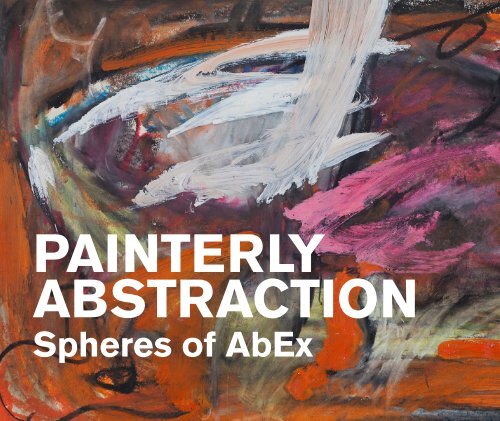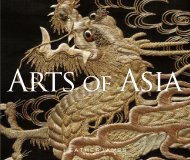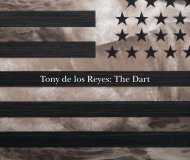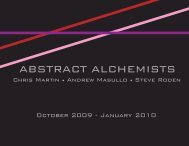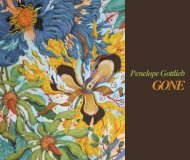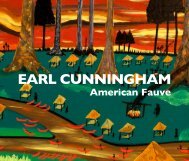Spheres of AbEx - Heather James Fine Art
Spheres of AbEx - Heather James Fine Art
Spheres of AbEx - Heather James Fine Art
You also want an ePaper? Increase the reach of your titles
YUMPU automatically turns print PDFs into web optimized ePapers that Google loves.
PAINTERLYABSTRACTION<strong>Spheres</strong> <strong>of</strong> <strong>AbEx</strong>
MARY ABBOTTKAREL APPELNORMAN BLUHMWARREN BRANDTLYNNE MAPP DREXLERFRIEDEL DZUBASLOUISE FISHMANSAM FRANCISJOHN GRILLOMICHAEL GOLDBERGHANS HOFMANNPAUL JENKINSWILLEM de KOONINGJOHN LITTLEMICHAEL LOEWROBERT NATKINLARRY POONSMILTON RESNICKROBERT RICHENBURGJACK ROTHMICHAEL CORINNE WEST
PAINTERLYABSTRACTION<strong>Spheres</strong> <strong>of</strong> <strong>AbEx</strong>
MARYABBOTT
UntitledSigned lower right Mary AbbottOil and oil stick on paper mounted to canvas23 x 29 inchesPainted circa 1951
UntitledSigned and dated lower right M. Abbott ‘54Oil and oil stick on paper mounted to canvas18 x 24 inchesPainted in 1954
PresenceSigned lower right M A;signed and titled onverso M. Abbott, PresenceOil on canvas46 x 87 inches
White SongSigned lower right A.Oil on canvas48 x 36 inches
KAREL APPEL (1921-2006) was a Dutch painter, sculptor, and poet. Hestarted painting at the age <strong>of</strong> fourteen and studied at the Rijksakademiein Amsterdam in the 1940s. He was one <strong>of</strong> the founders <strong>of</strong> the avantgardemovement Cobra in 1948. He was influenced by Pablo Picasso,Henri Matisse and the French <strong>Art</strong> Brut artist Jean Dubuffet. In breakingwith his Amsterdam youth, Appel distanced himself from the Cobra groupand became part <strong>of</strong> a group <strong>of</strong> artists known as <strong>Art</strong> Informel. Centered onMichel Tapié, the group included artists such as Henri Michaux, Willem deKooning, Jean-Paul Riopelle, Jackson Pollock and Sam Francis.
KARELAPPEL
Kra-13Signed lower right AppelAcrylic on canvas48 x 60 inchesPainted circa 1975
UntitledSigned and dated lower right Appel ‘73Acrylic on canvas19 x 30 1/2 inchesPainted in 1973
NORMAN BLUHM (1921-1999) embraced abstraction and propelled itforward, blending figurative elements, eroticism and calligraphic agility toarrive at a sensibility all his own. His work was informed less by movementsand orthodoxies than by his own exceptional biography and his richknowledge <strong>of</strong>, and respect for, the history <strong>of</strong> art. Bluhm was justifiablysecure enough in his talent and training to honor Europe and the history<strong>of</strong> art without compromising his identity as an American painter.Bluhm initially studied the Bauhaus approach to architecture while alsospending his spare time learning to fly. After the attack on Pearl Harborduring World War II, Bluhm became a B-Pilot and flew 44 missions overNorth Africa and Europe before getting wounded and sent home. After thewar he decided to discard his career as an architect and moved to Pariswhere he attended art classes at the Académie de la Grande Chaumiéreand Ecole des Beaux <strong>Art</strong>s. In 1956, he returned to New York and begana lifelong, successful career as an Abstract Expressionist painter. He waspart <strong>of</strong> a vibrant and glamorous “movement,” socializing with a handful <strong>of</strong>art-world titans and collaborating with the curator and poet Frank O’Harato create a legendary collection <strong>of</strong> “Poem Paintings.” An important figure inthe heyday <strong>of</strong> Abstract Expressionism, Bluhm enjoyed substantial criticalsuccess during his lifetime. His work is included in the collections <strong>of</strong> theMetropolitan Museum <strong>of</strong> <strong>Art</strong>, the Whitney and the Museum <strong>of</strong> Modern <strong>Art</strong>.However, he found greater solace in painting than in fame or academictheorizing about art. Gradually he moved farther and farther from New York,eventually settling in a still corner <strong>of</strong> rural Vermont. Bluhm was enthralledwith painting itself not fame or public relations. For him the studio was thecenter <strong>of</strong> the art universe and whether in Paris, New York, or Vermont heallowed himself to be led by its constant demands.
NORMANBLUHM
Tic-Tac-ToeSigned and dated lower left Bluhm ‘61Oil on paper mounted on board29 1/4 x 35 3/4 inchesPainted in 1961
A, 1961Signed and dated lower left Bluhm ‘61Watercolor and ink on paper29 3/4 x 22 inchesPainted in 1961
UntitledSigned and dated lower right Bluhm ‘62Oil and ink on paper laid down on canvas24 x 19 3/4 inchesPainted in 1962
Blue DipperSigned lower left BluhmOil on canvas96 x 72 1/4 inchesPainted in 1967
WARREN BRANDT (1918-2002) was born in Greensboro, N.C., andmoved to New York after high school, attending Pratt Institute. He studiedwith Yasuo Kuniyoshi at the <strong>Art</strong> Students League and, later worked asan <strong>of</strong>ficial portraitist in the Army during World War II. Brandt studied withPhilip Guston and Max Beckmann at Washington University in St. Louis,while maintaining connections with Abstract Expressionists in New York,consequently Brandt’s paintings reflected their influence. He traveledextensively in the 1950s, throughout Europe and from New York to NorthCarolina and Mississippi, where Brandt was teaching. In 1960 Brandtmoved to New York and made a radical change in his art, developing adistinctive painting style in nudes, still lifes and scenes from his studio.
WARRENBRANDT
Rock Island BlindSigned and dated lower right Warren Brandt ‘62Oil on canvas72 x 80 inchesPainted in 1962
LYNNE MAPP DREXLER (1928-1999) began her study <strong>of</strong> art as a child,painting landscapes by the tender age <strong>of</strong> eight. In the late 1950s, afterattending the College <strong>of</strong> William and Mary in Virginia, she immersed herselfin Abstract Expressionism, studying with Hans H<strong>of</strong>mann in both his NewYork and Provincetown schools. Later, she went on to graduate studyat Hunter College in New York City with Robert Motherwell. In the earlyworks Drexler focused on color and composition, eventually reconcilingher two interests—landscape and abstraction—in her late work <strong>of</strong> the1980s and 1990s. But it was in the 1950s that she set her foundation—asynthesis <strong>of</strong> Post-Impressionist landscape painting and Post-war painterlyabstraction. The results are something not familiar to most students <strong>of</strong>the period and her crisp, colorful brushwork allows the artist to sing witha completely original voice. When she lived in New York she regularlyattended concerts at Carnegie Hall where she would make sketcheswhile she was in the audience. Classical music remained an importantpart <strong>of</strong> her art. Her vibrant surfaces are both complex and painterly butwith a flatness akin to something found in the background <strong>of</strong> a GustavKlimt work. Drexler lived the last 16 years <strong>of</strong> her life on Monhegan Islandwith her husband, the painter John Hultberg.Drexler exhibited extensively throughout her life at venues such as TanagerGallery, Esther Robles Gallery and Westerly Gallery. Her work is part <strong>of</strong> thepermanent collections <strong>of</strong> the Museum <strong>of</strong> Modern <strong>Art</strong>, Monhegan Museum,Farnsworth Museum, Brooklyn Museum and the Queens Museum amongothers.
LYNNEMAPP DREXLER
Blue Horse - Red RiderSigned, titled and dated verso Lynne Drexler, Blue Horse-Red Rider, 1957-58Oil on canvas58 x 61 inchesPainted in 1957-58
UntitledSigned and dated verso L. Drexler ‘60Oil on canvas23 1/2 x 27 inchesPainted in 1960
Daffodil GlouchesterSigned, titled and dated verso Lynne Drexler, Daffodil Glouchester, 1960Oil on canvas23 3/4 x 25 inchesPainted in 1960
Early SpringSigned and dated lower left L.D. 59Oil on canvas40 x 58 inchesPainted in 1959
FRIEDEL DZUBAS (1915-1994) studied art in his native land beforefleeing Nazi Germany in 1939 and settling in New York City. In Manhattanduring the early 1950s, he shared a studio with fellow abstract painterHelen Frankenthaler. He began exhibiting his Abstract Expressionistpaintings at this time. His work was included in the “Ninth Street Show” inNew York City in 1951, and in group exhibitions at the Leo Castelli Gallery,the Stable Gallery, and the Tibor de Nagy Gallery among others.In the 1960s he became associated with Color Field painting andLyrical Abstraction. He was included in “Post-Painterly Abstraction” a1964 exhibition curated by Clement Greenberg. Dzubas was a friend<strong>of</strong> Greenberg, who in turn introduced him to Jackson Pollock and otherartists. During the last three decades <strong>of</strong> his career, Dzubas had more thansixty solo exhibitions around the world. He was represented by the AndreEmmerich Gallery and Knoedler Contemporary <strong>Art</strong>s in New York for morethan thirty years. In 1976 he settled in Massachusetts, but also paintedand lived in New York City, where his paintings were regularly exhibited.
FRIEDELDZUBAS
UntitledSigned and dated upper left Dzubas ‘61Oil on canvas43 x 30 inchesPainted in 1961
Red FlightSigned on versoOil on canvas68 1/2 x 91 1/2 inchesPainted in 1957
LOUISE FISHMAN (b. 1939) is recognized as one <strong>of</strong> the best knownAmerican abstract painters <strong>of</strong> her generation. Originally, her paintingstyle gave her some trouble in being recognized and she exhibited onlyoccasionally in the 60s when she produced primarily grid based work. Asthe feminist movement gained strength in the 70s, Fishman abandoned theMinimalist-inspired grid paintings and began making work that reflectedtraditional women’s tasks. She returned later to the masculine realm <strong>of</strong>abstract painting and fought her way to distinguish her work from the maleartists. The resulting compositions combine gestural brushwork with anorderly structure as if Fishman built or wove her paintings, starting froma foundation and carefully adding layer upon interlocking layer. Fishman’sabstractions, while not directly narrating her life, are rooted in her cultural,political and emotional experiences revealing Fishman’s unique version <strong>of</strong>Abstract Expressionism.
LOUISEFISHMAN
Casa CenoteOil on canvas58 x 76 inchesPainted in 2000
SAM FRANCIS (1923-1994) was born in San Mateo, California, andstudied botany, medicine and psychology at the University <strong>of</strong> California,Berkeley. He served in the United States Air Force during World War IIbefore being injured in a plane crash. He was in the hospital for severalyears with spinal tuberculosis, and it was while there that he began topaint. Once out <strong>of</strong> the hospital he returned to Berkeley, this time to studyart. Francis was initially influenced by the work <strong>of</strong> Abstract Expressionistssuch as Mark Rothko, Arshile Gorky and Clyfford Still. He spent the 1950sin Paris, having his first exhibition there in 1952. While there he becameassociated with Tachisme. He later spent time in Japan, and some haveseen an influence from Zen Buddhism in his work. Francis spent some timein Paris executing entirely monochromatic works, but his mature piecesare generally large oil paintings with splashed or splattered areas <strong>of</strong> brightcontrasting color. Areas <strong>of</strong> white canvas are <strong>of</strong>ten left to show through,and in later works, paint is sometimes confined to the edges <strong>of</strong> the canvas.Luminous and painterly, rather than gestural, his “signature” paintings <strong>of</strong>the early 1950s are overlays <strong>of</strong> serial but asymmetrical biomorphic formssaturated with color. The mid 50s saw Francis include fields <strong>of</strong> varioussized clusters <strong>of</strong> cell-like shapes usually in blue, yellow, and red on a whiteground. Francis returned to California during the 1960s and continuedpainting in Los Angeles. During the final three decades <strong>of</strong> his careerhis style <strong>of</strong> large scale bright Abstract Expressionism was also closelyassociated with Color Field painting.
SAMFRANCIS
Untitled (Black and White Composition)Signed on versoAcrylic on paper23 3/4 x 17 3/4 inchesExecuted in 1988
JOHN GRILLO (b. 1917) was raised in the small industrial town <strong>of</strong>Lawrence, Massachusetts. The 1930’s brought the family to Hartford,Connecticut where as a child growing he watched his father paint andsculpt. John would frequent the Wadsworth Antheneum Museum inHartford where the collection <strong>of</strong> portraits would inspire him to becomea portrait painter. In 1935 he enrolled in the Hartford School <strong>of</strong> <strong>Fine</strong> <strong>Art</strong>swhere he learned portrait and landscape painting.In 1948, Grillo attented the New York school <strong>of</strong> Hans H<strong>of</strong>mann and alsospent summers at H<strong>of</strong>mann’s school in Provincetown, Massachusetts. Inthe 1950s, he experimented with symbolism and action painting and gridlikepaintings consisting <strong>of</strong> small squares based on H<strong>of</strong>mann’s teachings.In the 1960s, Grillo’s paintings evolved into a series <strong>of</strong> oversize canvasesprimarily in a luminous yellow range that to the critics evoked the power<strong>of</strong> light and sunshine. One artist called Grillo the Renoir <strong>of</strong> AbstractExpressionism, another compared him to Rubens for his sensuality. Onecritic brought up Turner, while another waxed eloquently about Venetianluminosity. Exhibitions <strong>of</strong> these works appeared at the Howard WiseGallery and the Grace Borgenicht Gallery, both in New York. In the 1970sGrillo continued geometric paintings, this time on a larger scale in aconstructivist manner. Before retiring from the University <strong>of</strong> Massachusettsin 1991, Grillo produced a large mural representing the agrarian andacademic elements in the history <strong>of</strong> the town <strong>of</strong> Amherst, presided overby the illustrious native poet, Emily Dickinson.
JOHNGRILLO
UntitledSigned and dated lower left Grillo ‘50Gouache on paper20 x 26 inchesPainted in 1950
UntitledSigned and dated lower right JG ‘52Oil on canvas24 x 22 inchesPainted in 1952
MICHAEL GOLDBERG (1924-2007) began his artistic training at the <strong>Art</strong>Students League in New York (1938) and attended Hans H<strong>of</strong>mann’s school(1941-1942) before interrupting his studies to serve as a paratrooper inthe United States Army in North Africa, China, Burma, and India. AfterWorld War II, Goldberg resumed his classes with H<strong>of</strong>mann. He becameinvolved in the avant-garde New York art scene, meeting Franz Kline,Willem de Kooning, Jackson Pollock, and Milton Resnick among others.In 1951, Goldberg, under the name Michael Stuart, showed his paintingsin the “Ninth Street Show.” The following year he moved to 28 East 2ndStreet and joined the Club, gathering with other Abstract Expressionistpainters to exchange artistic ideas. Around this time, he met the poetFrank O’Hara, who became a life-long friend and dedicated many poemsto Goldberg. In addition, they collaborated on a project titled “Odes” in1960. Goldberg maintained his connection with the Abstract Expressionistpainters throughout the fifties and into the sixties.A second generation Abstract Expressionist artist, Michael Goldberg’spainting defies classification, having undergone numerous changesthroughout his long and prolific career. He painted dynamic, gesturalcanvases; monochromatic, minimalist works; grids; calligraphic images;patterned or striped paintings, and he experimented with collage.
MICHAELGOLDBERG
Winter Study #7Signed lower right GoldbergOil on board11 x 14 inchesPainted circa 1960
Landscape (On the way to New Lisbon, NY)Signed, titled and dated on versoOil and paper collage on canvas64 x 68 inchesPainted in 1964
HANS HOFMANN (1880-1966) is one <strong>of</strong> the most important figures<strong>of</strong> post-war American art. German born, he played a pivotal role in thedevelopment <strong>of</strong> Abstract Expressionism as an influential teacher <strong>of</strong>generations <strong>of</strong> artists in both Germany and America. In 1930 H<strong>of</strong>mannwent to teach at the University <strong>of</strong> Berkeley and in 1932 settled in NewYork where he taught art at the <strong>Art</strong> Students League and later againopened his own schools in Manhattan and Provincetown, Mass. For eageryoung American artists constrained by the aftermath <strong>of</strong> WWII and theDepression, contact with H<strong>of</strong>mann served as an invaluable connectionwith European Modernism. Noted art historian Clement Greenberg calledH<strong>of</strong>mann “in all probability the most important art teacher <strong>of</strong> our time.”His school remained a vital presence in the New York art world until 1958when the then seventy-eight year old H<strong>of</strong>mann decided to devote himselffull-time to painting. Combining Cubist structure and intense Fauvistcolor, H<strong>of</strong>mann created a highly personal visual language, continuouslyexploring pictorial structures, spatial illusion and chromatic relationshipsand creating volume through contrasts <strong>of</strong> color, shape and surface. Also aprominent writer on modern art, his push/pull theory is a culmination <strong>of</strong> many<strong>of</strong> his ideas and describes the plasticity <strong>of</strong> three-dimensionality translatedinto two-dimensionality. Due to a dazzling burst <strong>of</strong> creative energy whenhe was close to 70 years old, his most highly recognizable canvases arefrom the late 1950s and 1960s, paintings <strong>of</strong> stacked, overlapping andfloating rectangles and clear, saturated hues that assured his reputationand cemented him as a key member <strong>of</strong> the Abstract Expressionists.
HANSHOFMANN
The PotSigned and dated lower right H<strong>of</strong>mann 1950Oil on paper14 x 17 inchesPainted in 1950
PAUL JENKINS (b. 1923) was raised near Youngstown, Ohio. Afterlater moving to New York, Jenkins became a student <strong>of</strong> Yasuo Kuniyoshiat the <strong>Art</strong> Students League and became associated with the AbstractExpressionists. Jenkins work is influenced by his interest in Easternreligions and philosophy, the study <strong>of</strong> the I Ching, along with the writings <strong>of</strong>Carl Jung prompted Jenkins’ turn toward inward reflection and mysticismwhich have dominated his aesthetic as well as his life.
PAULJENKINS
Phenomena Prism Wind AnvilSigned lower left JenkinsOil on canvas60 x 50 inchesPainted in 1983
WILLEM de KOONING (1904-1997) was a Dutch American artist whowas born in Rotterdam, the Netherlands. In the post-World War II era,de Kooning painted in a style that came to be referred to as AbstractExpressionism and was part <strong>of</strong> a group <strong>of</strong> artists that came to be knownas the New York School. The hallmark <strong>of</strong> de Kooning’s style was anemphasis on complex figure ground ambiguity. Background figures wouldoverlap other figures causing them to appear in the foreground, which inturn might be overlapped by dripping lines <strong>of</strong> paint thus positioning thearea into the background. De Kooning had painted women regularly inthe early 1940s and again from 1947 to 1949. The biomorphic shapes<strong>of</strong> his early abstractions were derived from objects found in the studio.But it was not until 1950 that he began to explore the subject <strong>of</strong> womenexclusively. In the summer <strong>of</strong> that year he began Woman I, which wentthrough innumerable metamorphoses before it was finished in 1952. Fromthe late 1950s to the early 1960s, de Kooning entered a new phase <strong>of</strong>nearly pure abstractions more related to landscape than to the humanfigure. These paintings, such as Bolton Landing (1957) and Door to theRiver (1960) bear broad brushstrokes and calligraphic tendencies similarto works <strong>of</strong> his contemporary Franz Kline. In 1963, de Kooning movedpermanently to East Hampton, Long Island, and returned to depictingwomen while also referencing the landscape in such paintings as Woman,Sag Harbor and Clam Diggers. He also turned to sculpture in later years,creating a number <strong>of</strong> works that were later cast in bronze.
WILLEMde KOONING
Two FiguresSigned lower left de KooningWatercolor on paper10 1/4 x 10 1/4 inchesPainted in 1972
JOHN LITTLE (1907-1984) was born in Sanford, Alabama. He left homewhen only 14 to study art in Buffalo, NY, at the <strong>Fine</strong> <strong>Art</strong>s Academy. In 1933,Little enrolled at the <strong>Art</strong> Students League studying under George Grosz.Four years later, at the age <strong>of</strong> 30, he began studies with Hans H<strong>of</strong>mann,both in New York and Provincetown. This marked his move towardsabstraction and his serious engagement as a painter. After service in theNavy during WWII Little returned to New York, moving into H<strong>of</strong>mann’s 8thStreet Studio where his neighbors were Pollock and Krasner. This wasa period <strong>of</strong> great experimentation influenced by Surrealist automatism,Picasso and H<strong>of</strong>mann.In 1946, Little was given his first solo exhibition at the California Palace<strong>of</strong> the Legion <strong>of</strong> Honor in San Francisco with a follow up one-man showin 1948 at Betty Parsons’s New York gallery. In the 1950s, his paintingbecame extremely gestural with aggressively applied, thick paint. He alsobegan a series <strong>of</strong> experimental mixed-media assemblage works createdfrom debris found on the beaches <strong>of</strong> Montauk. Hans Namuth documentedthese works in his 1955 film, “Image <strong>of</strong> the Sea.” In that same year Littlehad a two-man exhibition at Guild Hall with Pollock, and in 1957 he foundedthe Signa Gallery along with Alfonso Ossorio and Elizabeth Parker. Signa,which lasted for four years, mounted innovative exhibitions and became ahighly important summertime venue showcasing the best <strong>of</strong> the New Yorkart scene. In the 1960s Little’s abstract style evolved with a flattening <strong>of</strong>the paint layer and massed areas <strong>of</strong> color overlapping and interlocking inan endless variety <strong>of</strong> compositions.
JOHNLITTLE
Ominous NightSigned and dated lower left John Little 1951Oil on canvas43 1/2 x 70 3/4 inchesPainted in 1951
AgallalaSigned, titled and dated on versoOil on canvas46 x 60 inchesPainted in 1974
MICHAEL LOEW (1907-1985) was one <strong>of</strong> the major proponents <strong>of</strong>Abstract Expressionism and influenced by the Neo-Plasticism <strong>of</strong> Mondrian.Despite their opposing approaches to abstraction, he became a longtimefriend <strong>of</strong> Willem de Kooning, whom he met completing WPA projectsduring the 1930s. Although Loew began his Neo-Plasticist mode duringthe 1940s, it was the 50s that brought the full development <strong>of</strong> his maturestyle. After World War II, Loew studied with Hans H<strong>of</strong>mann and cultivatedhis sensibility for color effects. He used the grid-structure <strong>of</strong> Mondrianas a base from which to experiment with the possibilities <strong>of</strong> the palette;to focus on subtle transitions <strong>of</strong> tone or harmony <strong>of</strong> color relationships.Drawing inspiration from life, he transformed subjects into unique patterns<strong>of</strong> rectangles or color fields, naming the final composition according to thedominant colors. He exhibited these works at the Stable Gallery annuals,beginning a full and successful exhibition career.In 1957, Loew participated in the International Association <strong>of</strong> Plastic<strong>Art</strong>s Touring Exhibition, Contemporary American Painting as juror andexhibitor. Here he exhibited alongside Milton Avery, Samuel Adler, JosefAlbers, de Kooning, Reinhardt, Walkowitz and others. The same yearhe gained representation at Zabriskie Gallery, next to Johns, Motherwell,and Rauschenberg. A recognized pillar <strong>of</strong> American Modernism, Loewmaintained an active teaching and exhibition schedule until his death in1985.
MICHAELLOEW
ArcadianSigned lower right LoewOil on canvas69 3/4 x 45 inchesPainted in 1959
Space Forms, 1952, No. 7Signed and dated lower right Loew 52Pastel on paper14 3/4 x 13 1/2 inchesExecuted in 1952
Untitled (Space Forms)Signed and dated lower right Loew 54Pastel on paper11 1/2 x 8 inchesExecuted in 1954
Green DepthsSigned lower left LoewOil on canvas76 x 54 inchesPainted in 1961
ROBERT NATKIN (1930-2010) was born in Chicago and graduatedfrom the <strong>Art</strong> Institute <strong>of</strong> Chicago in 1952. Natkin’s art blends AbstractExpressionism with Post-Impressionist colors. His work <strong>of</strong>ten runs inseries he created using columns, grids and shifting planes that includethis early jazz oriented example titled Coltrane. These works, with verticalstripes alternating between thick and thin, decorative and textured, arecheerful and light, invoking a specific lyricism. His painting is inspired bythe color used by Henri Matisse and Pierre Bonnard, and the Cubism <strong>of</strong>Paul Klee. In 1959, Natkin joined a group <strong>of</strong> other artists from Chicagoin an exodus to New York, where he began teaching and exhibiting hispaintings.
ROBERTNATKIN
UntitledSigned lower right NatkinPastel on paper17 x 22 inchesExecuted circa 1957
UntitledSigned lower right NatkinMixed media on paper24 x 24 inchesExecuted circa 1957
LARRY POONS (b. 1937) is an abstract painter whose early ambitionafter high school in 1955 was to study music. While attending musicschool, he began to take his painting more seriously. In 1959, he enrolledat the School <strong>of</strong> the Museum <strong>of</strong> <strong>Fine</strong> <strong>Art</strong>s, Boston, and also studied atthe <strong>Art</strong> Students League <strong>of</strong> New York. He rose to prominence in the1960s with paintings <strong>of</strong> circles and ovals on solid, <strong>of</strong>ten brilliantly colored,backgrounds. These paintings conveyed a sense <strong>of</strong> movement, and werecategorized as Op <strong>Art</strong>. Although he exhibited with optical artists in 1965,by 1966 he had moved away from this style towards looser and morepainterly abstract canvases. Poons’ work is associated with Op <strong>Art</strong>, Hardedgepainting, Color Field painting, Lyrical Abstraction and AbstractExpressionism.
LARRYPOONS
1st TwistSigned and dated verso Larry Poons 1978Acrylic on canvas81 x 72 inchesPainted in 1978
MILTON RESNICK (1917-2004) was born in Russia, and arrived in NewYork City in 1922 at age five. At age 14, he enrolled in the American <strong>Art</strong>istsSchool in New York and with classmate Ad Reinhardt, the two shared abudding interest in abstraction. In 1948, Resnick returned to New York,enrolling in Hans H<strong>of</strong>mann’s school. He also took a studio on East 8thStreet, near Jackson Pollock, de Kooning, and Franz Kline. During the1950s and 1960s, Resnick became noted for his paintings after exhibitingin the famous “Ninth Street Show” and was included in all five <strong>of</strong> theStable Gallery annuals. Additionally, Resnick was a founding member <strong>of</strong>the Club, the Abstract Expressionist forum.
MILTONRESNICK
ReturnSigned and dated lower left Resnick 60Oil on paper mounted on Masonite83 1/2 x 53 inchesPainted in 1960
ROBERT RICHENBURG (1917-2006) studied at the Corcoran Galleryand the <strong>Art</strong> Students League. Upon his return from the war in 1947, hesettled in New York to study with Amedee Ozenfant and Hans H<strong>of</strong>mann.He was then introduced to artists Ibram Lassaw and Willem de Kooning.In 1949 when the Club was formed, Richenburg was an active member.He showed in the “Ninth Street Show” and was included in three StableGallery annuals.
ROBERTRICHENBURG
Orange AlertSigned lower right RichenburgOil on canvas15 1/8 x 18 inchesPainted in 1951
Lively MelodySigned lower left RichenburgOil on paper mounted to board14 x 17 inchesPainted in 1949
Green RiverSigned and dated upper right Richenburg ‘59Oil on canvas stretched over panel26 x 16 1/2 inchesPainted in 1959
Whip DanceSigned and dated lower left Richenburg ‘50Oil on paper15 x 18 inchesPainted in 1950
JACK ROTH (1927-2004) was known as an Abstract Expressionist andColor Field painter. After studying with Mark Rothko at the CaliforniaSchool <strong>of</strong> <strong>Fine</strong> <strong>Art</strong>s, he received a Masters degree in fine arts from theState University <strong>of</strong> Iowa in 1952, and a Doctorate degree in mathematicsfrom Duke University in 1962. In 1979, he was awarded a GuggenheimFellowship and in 1982 he received a New Jersey Council on the <strong>Art</strong>sAward. He exhibited paintings in the Solomon R. Guggenheim Museum“Younger American Painters” (May 12 to July 25, 1954) - alongside WilliamBaziotes, Morris Louis, Richard Diebenkorn, Adolph Gottlieb, PhilipGuston, Franz Kline, Willem de Kooning, Robert Motherwell, JacksonPollock and others. This was one <strong>of</strong> the first major exhibitions <strong>of</strong> AbstractExpressionism at an American art museum.
JACKROTH
Untitled (Rope Dancer series)Signed lower center R 80Acrylic on canvas18 x 30 inchesPainted in 1980
Untitled (Dance to the Music <strong>of</strong> Spring)Signed and dated verso Roth ‘81Acrylic on canvas18 x 22 inchesPainted in 1981New Synthesis #35Signed and dated verso Roth ‘81Acrylic on canvas48 x 40 inchesPainted in 1981
Rope Dancer 8 - For Man RaySigned lower left Roth 80Acrylic on canvas50 x 67 inchesPainted in 1980
MICHAEL CORRINE WEST (1908-1991) was born in Chicago andspent most <strong>of</strong> her formative years in Ohio. She enrolled in the Cincinnati<strong>Art</strong> Academy in 1925, after opting for a career in the fine arts. Westmoved to New York in 1932, continuing her art education in 1933 at the<strong>Art</strong> Students League. West was a member <strong>of</strong> Hans H<strong>of</strong>mann’s first classat the League and he remained a lasting influence on her art. H<strong>of</strong>mann’semphasis on the “inner eye,” the ability to apprehend the essence <strong>of</strong>things, guided the artist in her spiritual approach to abstraction.West developed a romantic relationship with the artist Arshile Gorky whointroduced her to European Surrealism, an important source for her work.In 1946, West became active in the burgeoning post-war art culture <strong>of</strong>New York City later marrying the avant-garde filmmaker and photographerFrancis Lee. Through Lee, West made the acquaintance <strong>of</strong> fellow artistJackson Pollock, with whom she shared an emphasis on the painterlyprocess as well as the assertion <strong>of</strong> the spiritual nature within the language<strong>of</strong> abstraction.
MICHAELCORRINE WEST
Cythera ShrineSigned, titled and dated on versoOil on canvas74 1/2 x 48 inchesPainted in 1979
SummerSigned and dated lower left Michael West 1963Oil on canvas89 x 48 inchesPainted in 1963
45188 Portola Avenue Palm Desert, CA 92260 760-346-8926PO Box 3580 172 Center Street Suite 101 Jackson, WY 83001 307-200-6090www.heatherjames.com


